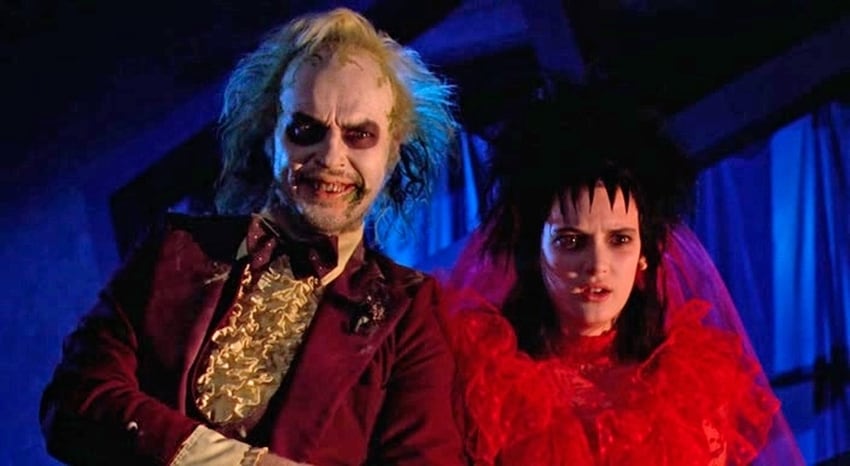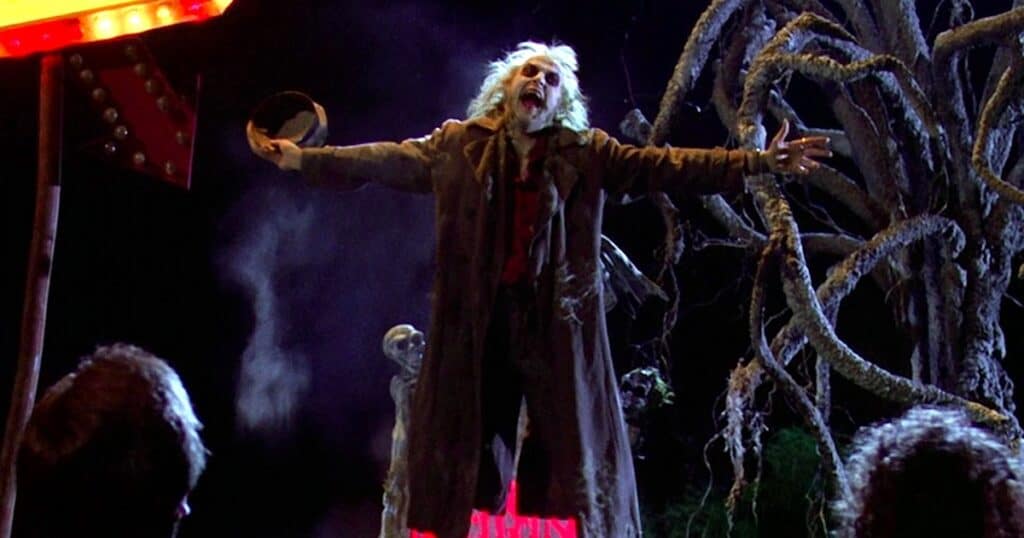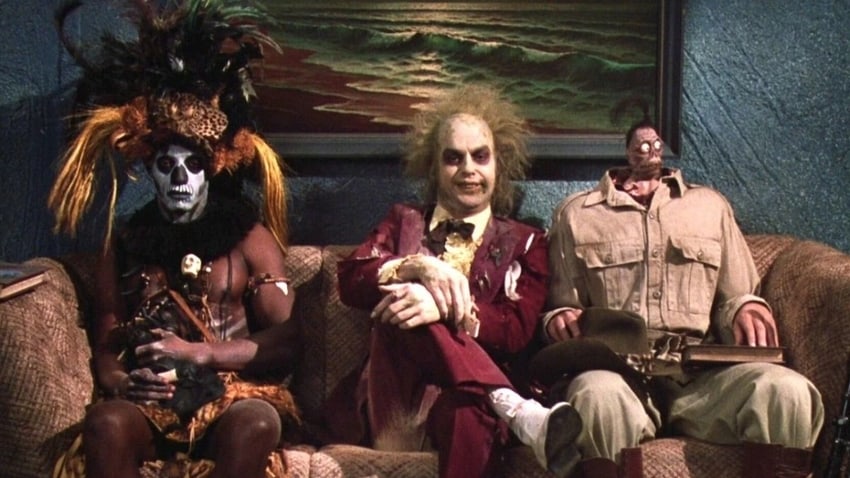Beetlejuice, Beetlejuice, Bee–ah, that was a close one! A massive success upon release, Beetlejuice went through a strange and unusual production that saw multiple rewrites and firings, not to mention the dodging of some seriously questionable casting choices. But through the terrific performances by its cast and creative skirting around a small budget, the movie became one of the best horror-comedies ever, worthy of a sequel that has been in development hell for over three decades.
So let’s open up the handbook for the recently deceased and shake, shake, shake senora because it’s showtime! Let’s to find out…WTF Happened to this movie?!
Following the massive success of Pee-wee’s Big Adventure, which pulled in $40 million on a $7 million budget, Tim Burton had his pick of what his next project would be. One thing he knew, it wouldn’t be talking horse movie Hot to Trot. Instead, he set his sights on the Bat-Signal, planning to adapt Batman. But when that didn’t pan out (yet!), he came across a script courtesy of David Geffen.
That screenplay, by Michael McDowell, was titled Beetlejuice (and that’s with two words, just as the opening credits indicate, even though the poster shows it as one). Before Geffen took over, Larry Wilson was brought along to play with the script, which the two took to Universal, where he told Den of Geek he was warned: “This piece of weirdness, this is what you’re going to go out into the world with? You’re developing into a very good executive. You’ve got great taste in material. Why are you going to squander all that for this piece of shit.”
Once Geffen hired Burton as director, he basically canned McDowell and Wilson over “creative differences” both in favor of teaming with Warren Skaaren (Beverly Hills Cop II) to incorporate more humor into the script. And it needed it, as McDowell’s script was dark; as in, oh, we’ll show you a car crash all right. As in, Barbara “wailing in pain and fright” after one of the covered bridge pilings impales her arm. As in, it’s not a dog that causes the accident but a group of mad hunters. As in, Beetlejuice was a murderous asshole who wanted the Deetz family dead and not a lecherous perv after a child bride (OK, so the final draft was disturbing, too). It might not be a surprise that Wes Craven was once attached…
There were other major changes made. In the original versions, Betelgeuse has wings, snake eyes and the features of a Middle Eastern man. There was also a younger sister for Lydia Deetz named Cathy, who would at one point be attacked by Betelgeuse in squirrel form. Further, Lydia was supposed to die in a fire. These were creative differences alright!
And so casting could begin. As for the title role, Burton wanted Sammy Davis Jr. for some goddamn reason, while producers were aiming for the likes of Bill Murray, Jack Nicholson, Tim Curry, Christopher Lloyd, Dudley Moore, and Sam Kinison. In describing the character, Wilson said he was “Groucho Marx from Hell”, which somehow screamed Mr. Mom.
Michael Keaton contributed greatly to the look of Betelgeuse, including the “finger in an electrical outlet” hair, nasty-ass teeth and moldy face. He even reportedly partly based the look on Chop Top in TCM 2. He also had a lot of say in Betelguese’s dialogue, ad-libbing the bulk of his lines through his mere two weeks of shooting.
Meanwhile, Alec Baldwin and Geena Davis would play the recently deceased Adam and Barbara Maitland. Lydia Deetz–the proto-Hot Topic mascot–would be Winona Ryder, beating out Justine Bateman, Jennifer Connelly, Lori Loughlin, Alyssa Milano, Sarah Jessica Parker, Molly Ringwald, Brooke Shields, and more, with her performance in LUCAS sealing it for Burton. Ryder hoped the role would bring her popularity in school; instead, she was labeled a “witch” due to her look, which was inspired by the female audience at a Cure concert.
Lydia’s parents would be played by Jeffrey Jones (Charles Deetz) and Catherine O’Hara (Delia Deetz)–Cheers wouldn’t let Kirstie Alley do it, although Anjelica Huston was closest to the role, even edging out Sigourney Weaver, Linda Hamilton and more. The supporting cast would include TV icons (Dick Cavett), crooners (Robert Goulet) and classic Hollywood stars (Sylvia Sidney).
Greenlit at a $15 million budget, Beetlejuice began production on March 11, 1987. Two key contributors would be production designer Bo Welch and cinematographer Tom Ackerman, who worked closely with Burton to build the aesthetic from his vivid storyboards. Burton pointed them to German Expressionism, although Burton didn’t pinpoint specific movies, but rather moods and tones. (As a bonus, Welch would later marry Catherine O’Hara.) Exteriors were shot in the small Vermont town of East Corinth–standing in for Winter River, Connecticut–which the team found through postcards). It was there the crew constructed the iconic house, the covered bridge the Maitlands drive off of. The rest of the movie was shot in Culver City, California. As far as how the afterlife was conceived, it was decided that it should feel like a “dreary government office” that had a limitless perspective. Sounds about right!

Just $1 million of the budget was designated for visual effects, a lot of which was practical work, mirror shots and stop-motion. So that decapitated Alec Baldwin? Yeah, all trickery, with the actor behind a black show card. And the mirror scene where Barbara holds a horse statue in front? The team turned the glass around so it faced the room, moved the actors to the other side and “you’re looking into the set but the fireplace had been turned around and the mirror had been taken out. Really simple,” said art director Tom Duffield. But no, the sandworms were created in post-production.
There was some simple trickery in the famous “Day-O” scene, too. After problems achieving the desired effect of the shrimp-hands grabbing the guests’ faces, Dick Cavett recommended Burton try shooting the shot in reverse. Regarding the song, Burton wanted to use a track by pop band The Ink Spots. It was actually Jeffrey Jones that gets credit for choosing “Day-O (The Banana Boat Song)” by Harry Belafonte, lending the most crucial component to the scene. And to think the studio wanted to cut it (anecddotally, actor Glenn Shadix, who played Otho, had “Day-O” play at his funeral).
Another terrific moment had some afterthought to it as well. The last scene, in which Beetlejuice gets his head shrunken, was added after production wrapped as a way to send the audience out on a high note. The other close originally had Lydia dancing to “When a Man Loves a Woman” instead of “Jump in the Line (Shake, Senora)”–what, no “Lovecats” for the Cure fans?
After the movie wrapped and the movie awaited release, Warner Bros. announced they want to rename Beetlejuice to House Ghosts. Burton retaliated with another alternative: Scared Sheetless. The title, of course, would remain Beetlejuice (and Keaton only had to be in the movie for 17 minutes to secure the title!).
Retrospectively, star Alec Baldwin told GQ, “When we did Beetlejuice, I had no idea what it was about. I thought my–all of our–careers are going to end with the release of this film. Maybe we’re all going to be dead.” But Baldwin and company would have little to worry about, as Beetlejuice opened on March 30th, 1988, at #1, going on to gross $73.7 million and become the 10th highest-grossing movie of 1988, behind Cocktail, Moonstruck and Die Hard.
The soundtrack would also do remarkably well. Composed mostly of Danny Elfman’s memorable score (it also featured two Harry Belafonte songs), the soundtrack his the Billboard 200 and charted for six weeks.
Beetlejuice didn’t just fare well with critics (Pauline Kael called it a “comedy classic”) but also on the awards circuit. At the Saturn Awards, it took home Best Horror Film, Best Supporting Actress (Sylvia Sidney as Juno) and Best Makeup, with another five nominations. But its biggest accolade came at the 61st Academy Awards, where Beetlejuice won the Best Makeup Oscar, besting Coming to America and Scrooged (we all know Keaton should have been nominated for Best Supporting Actor).

And its legacy hasn’t even begun to slow down. It’s consistently ranked as one of the best horror-comedies ever, and the American Film Institute would later rank it as the 88th funniest movie ever made.
The year after its release came an animated series developed by Burton, which had Beetlejuice and Lydia as buddies going on weird little romps. There, too, were video games, including a totally passable one for NES (you know, given the property). Thirty years after Beetlejuice came out came the musical, which opened in 2018 in Washington D.C. before hitting Broadway in 2019, closing temporarily during the Covid-19 pandemic before officially bowing in 2023. In the title role was Alex Brightman, who also voiced the character on an episode of TEEN TITANS GO!
And then there was the sequel…and then there wasn’t…and then there was again…and then…Talk of Beetlejuice sequel began as early as 1990, with Jonathan Gems (later of MARS ATTACKS!) set to pen Beetlejuice Goes Hawaiian, which would find the Deetz family off to Hawaii and Betelgeuse turning into something called Juicifer. Burton was game, apparently wanting a German Expressionist beach movie hybrid: so think Dr. Caligari meets Frankie & Annette. Even Keaton and Ryder were attached, but the project was pushed aside for Batman Returns. In 1991, Burton approached Daniel Waters (Heathers, thus a Winona Ryder connection), while Warner Bros. hired Pamela Norris (SNL) in 1993. Kevin Smith even gave it a poke in 1996 but ditched it for Superman Lives (another failed Tim Burton project). He later said, “Must we go tropical?”
There was also another screenplay circling development by Warren Skaaren called BEETLEJUICE IN LOVE, in which Betelgeuse would chase the tail of a woman who recently lost her would-be-fiance after falling from the Eiffel Tower while proposing.
As far as a more modern timeline on the Beetlejuice sequel: in 2011, Seth Grahame-Smith (later Dark Shadows, also directed by Burton) was set to write; in 2013, Ryder hinted at a return; the following year, Burton confirmed a screenplay was in the works; in 2015, Ryder again confirmed her return; in 2017, Mike Vukadinovich (TV’s Kidding) was hired for a rewrite; in 2019, Warner Bros. announced it was shelved. In 2022, Burton neither confirmed nor denied his involvement, and finally, the rumour mill suggested that Wednesday star Jenna Ortega would be co-starring in the long-awaited Beetlejuice 2. Now, finally, we can confirm that the movie is indeed happening, with Warner Bros officially giving it a September 6th, 2024 release date yesterday!
Originally published at https://www.joblo.com/wtf-happened-to-beetlejuice/




